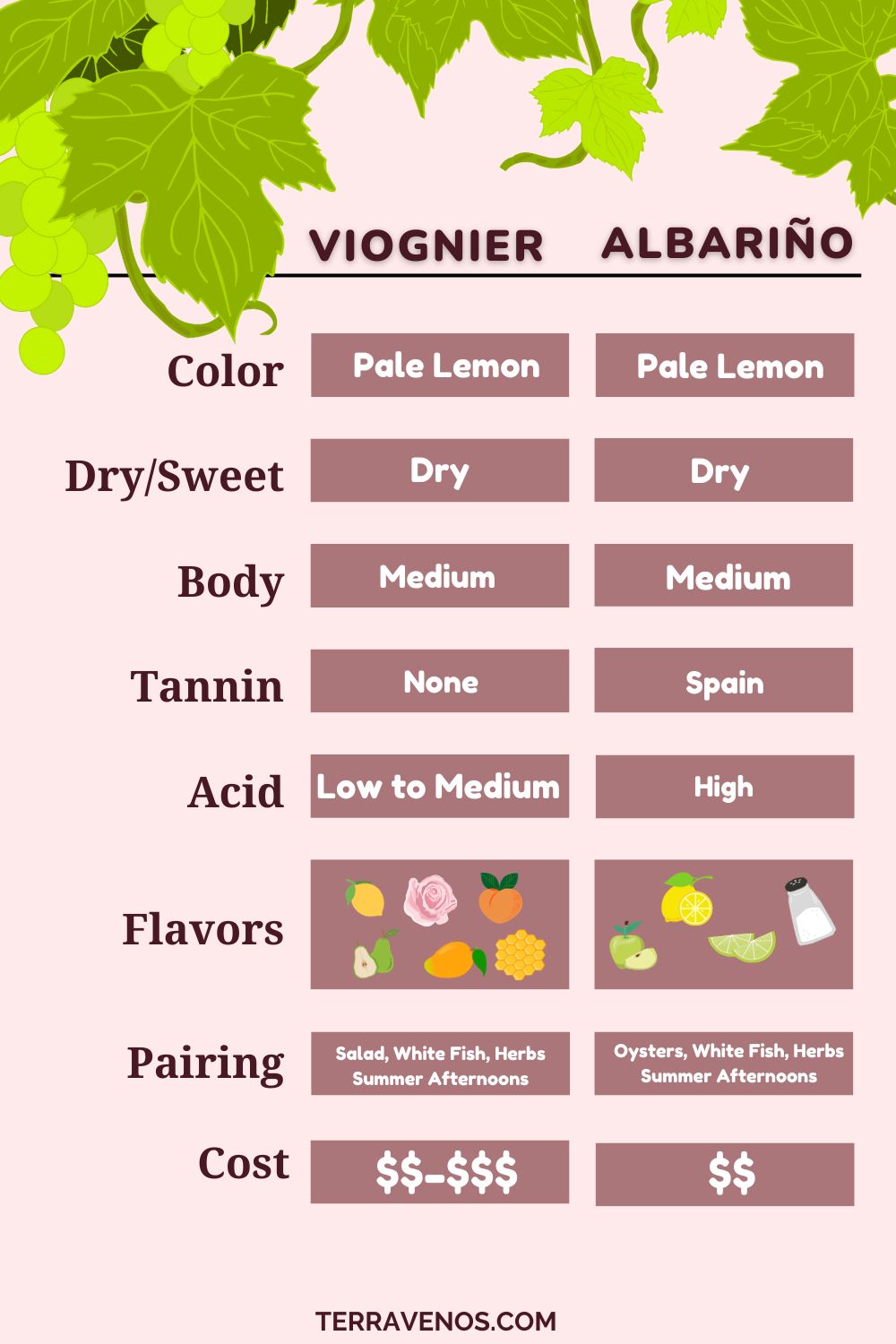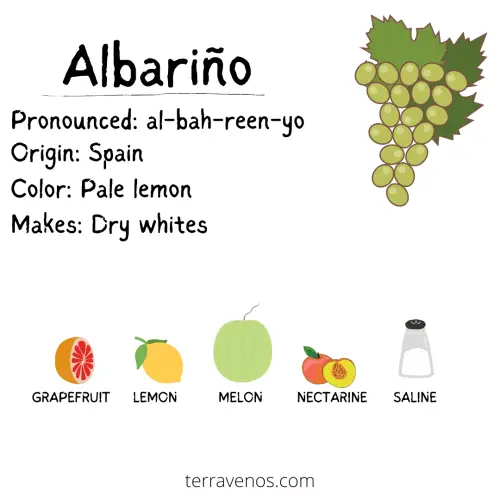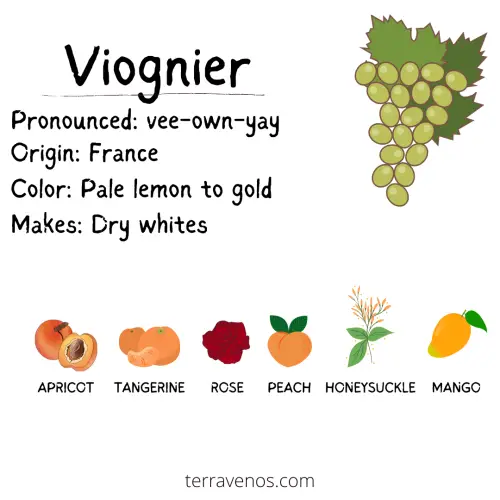
Albariño vs Viognier is an interesting comparison because these are distinctive white wines.
Albariño is a dry, leaner, citrus-driven white wine with high acid. Viognier is a low-acid, fuller-bodied white wine with stone fruit and florals.
TL;DR: If you love Albariño, you may or may not enjoy Viognier.
Here’s what you need to know about the differences between Albariño and Viognier
Albariño Basics: Spain’s Signature White

Albariño, a gem from Spain’s Rías Baixas region in Galicia, captures the essence of its maritime terroir. This zesty white wine boasts a vibrant acidity that enlivens the palate. Albariño embodies refreshing citrusy notes, accompanied by hints of floral elegance.
Its crisp and invigorating profile makes it a perfect companion for seafood dishes. Think oysters, fish and chips, ceviche, and more.
In Rías Baixas, where Albariño reigns supreme, the wine reflects the region’s coastal charm. The combination of cool ocean breezes and mineral-rich soils imparts a unique character to the grapes, resulting in wines that embody the spirit of the Galician coastline. Helpful Tip: Go check out this post for a deep dive into Albariño wine.
Fun Wine Fact: The name “Albariño” is derived from the word “Alba,” which means white in Galician, reflecting the grape’s light color.
Viognier Basics: Full-bodied and Fruity

Viognier, originating from the Rhône Valley in France, is an aromatic, fruity white wine that has a fuller, luscious body. It has classic notes of stone fruit, like peach and apricot, along with honey, rose, and tangerine.
You’ll find Viognier grown in South Africa, Australia, and California as well.
Helpful Tip: If you’re new to Viognier, here’s a quick Viognier wine guide to help you appreciate its unique characteristics.
Wine Comparison: Albariño vs Viognier
Here’s a side-by-side comparison highlighting the key differences and similarities between Albariño and Viognier.
| Characteristics | Albariño | Viognier |
|---|---|---|
| Hue | Pale to medium lemon | Medium lemon to gold |
| Color | White | White |
| Aromas | Citrus, peach, apricot, saline | Stone fruit, floral, honeysuckle |
| Sweetness | Dry | Dry to off-dry |
| Acid | High | Low to Medium |
| Alcohol (%) | 11-13% | 13-14% |
| Body | Light to medium | Medium plus to full |
| Intensity | Medium to medium plus | Medium to pronounced |
| Key Growing Regions | Spain (Rias Baixas), Portugal, California | France (Condrieu), Rhone Valley, California |
| Classic Pairings | Seafood, shellfish, light salads, grilled veggies | Chicken, pork, spicy cuisine |
| Price Range | $15-$30 | $15-$40 |
Albariño Wine Profile
- Sweetness: Albariño wines tend to be dry, offering little to no residual sugar.
- Alcohol: Typically, Albariño wines have a moderate alcohol content, ranging from around 11% to 13% ABV.
- Body: Albariño wines generally have a medium body, providing a satisfying weight on the palate, but lighter than Viognier
- Acid: Albariño is renowned for its vibrant acidity, which adds freshness and liveliness to the wine, higher than Viognier.
- Aroma and Intensity: Albariño boasts pronounced flavors and aromas, with a focus on citrus notes, especially lemon and lime.
- Flavors: In addition to citrus, Albariño often exhibits flavors of green apple, peach, apricot, and sometimes a hint of saline minerality.
Viognier Wine Profile
- Sweetness: Viognier tends to be made in dry styles, but less expensive wines may be off-dry
- Alcohol: Viognier wines typically have a moderate to high alcohol content, ranging from around 13% to 15% ABV.
- Body: Viognier is known for its full-bodied, creamy texture on the palate.
- Acid: While still providing freshness, Viognier tends to have lower acidity compared to Albariño.
- Flavor and Aroma Intensity: Viognier boasts intense floral and stone fruit aromas with a rich, honeyed character.
- Flavors: Expect flavors of apricot, peach, honeysuckle, and sometimes a hint of spice.
Are Albariño and Viognier Similar?
Yes, Albariño and Viognier are similar. They are made using protective winemaking techniques to preserve their aromatic freshness.
What Is the Difference Between Albariño and Viognier?
Albariño is higher in acid and lighter in body than Viognier. Albariño has a distinctive saline and mineral note. Viognier is more perfumed and floral and tastes a bit like fruit cocktail. Viognier is a fuller-bodied, lower acid wine than Albariño.
Albariño vs Viognier: Winemaking
Winemakers commonly ferment both Albariño and Viognier in stainless steel tanks, preserving their freshness and fruit-forward flavors.
Fun Fact: Viognier is often co-fermented with Syrah wine to give help stabilize the red wine’s color and give it floral aromatics. Who knew?
Albariño vs Viognier: Food Pairings and Serving Temperature

- Viognier’s full-bodied and aromatic nature makes it an excellent companion for richer dishes, including creamy pasta and oven-roasted poultry.
- Albariño’s clean and linear character makes it a versatile partner for seafood, light pasta dishes, white meats, and mild cheeses. It’s also a fantastic wine for sipping on a warm afternoon.
Helpful Tip: If you’re just getting started with wine, head over to the post that covers just the basics of food and wine pairing.
Albariño and Viognier Serving Temperature
| Wine | Ideal Serving Temperature |
|---|---|
| Albariño | Chilled (around 45-50°F or 7-10°C) |
| Viognier | Chilled (around 52-56°F or 8 -12°C) |
Both Albariño and Viognier are best served chilled, allowing their refreshing qualities to shine through. Take them out of the fridge and enjoy.
Most Albariño and Viognier wines are ready to drink immediately after opening, with no need for decanting or extended aeration.
Which Is More Expensive, Albariño vs Viognier?
It’s natural to want to compare costs when comparing wines.
Albariño Cost
- Entry-level Albariño wines also come at accessible prices, usually falling within the $10 USD range per bottle. These wines are known for their vibrant acidity and refreshing characteristics, making them versatile for casual sipping or food pairing.
- On the premium side, Albariño reveals its elegance and expressive flavors. Premium Albariño wines, sourced from renowned regions, can be priced from $25 to $50 or even higher, delivering a memorable drinking experience.
Viognier Cost
- Entry-level Viognier wines are usually priced between $15 and $20 per bottle. These are lovely bottles that are a good place to start.
- Premium Viognier from renowned regions or prestigious wineries can range from $20 to $40 or more, reflecting their exceptional craftsmanship.
Helpful Tip: Albariño is definitely a wine you’ll find at your local grocery store. Check out this post for 9 quick tips on how to buy great grocery store wines.
Which Is Better: Albariño or Viognier?
If you enjoy a zesty and vibrant wine with citrus and tree fruit, try Albariño. If you like more aromatic, perfumed white wines with rich stone fruit and florals and a fuller body, then stick with Viognier.
Personal Note: I love Viognier. I think it gets overlooked. Whenever I find a bottle at my discount grocer, I grab it for a special mid-week treat.
Final Thoughts – Albariño or Viognier?
Both Albariño and Viognier are lovely wines with unique personalities. Ready to get started comparing the two?
- Hosting a side-by-side tasting is the best way to explore the differences between these two classic white wines.
- Get yourself 2 bottles of similarly priced Albariño and Viognier, invite a few friends over, and do your own tasting.
Albariño presents a lively and refreshing profile with a saline kiss, making it a fantastic choice for warm days and light dishes. Viognier, with a plusher perfumed personality, couldn’t be more different.
Discover More:
Viognier vs Riesling
Pinot Grigio vs Albarino
Chardonnay vs Pinot Grigio
Gruner Veltliner vs Riesling
Pinot Grigio vs Vermentino
Thirsty for More?
If you’re eager to delve further into the world of wine, consider hosting your own wine tasting for beginners.
Explore other side-by-side comparisons such as Sauvignon Blanc vs. Chardonnay, and delve into the signature wines from famous wine regions worldwide.



